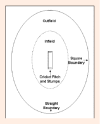Acceleration kinematics in cricketers: implications for performance in the field
- PMID: 24570616
- PMCID: PMC3918548
Acceleration kinematics in cricketers: implications for performance in the field
Abstract
Cricket fielding often involves maximal acceleration to retrieve the ball. There has been no analysis of acceleration specific to cricketers, or for players who field primarily in the infield (closer to the pitch) or outfield (closer to the boundary). This study analyzed the first two steps of a 10-m sprint in experienced cricketers. Eighteen males (age = 24.06 ± 4.87 years; height = 1.81 ± 0.06 m; mass = 79.67 ± 10.37 kg) were defined as primarily infielders (n = 10) or outfielders (n = 8). Timing lights recorded 0-5 and 0-10 m time. Motion capture measured first and second step kinematics, including: step length; step frequency; contact time; shoulder motion; lead and rear arm elbow angle; drive leg hip and knee extension, and ankle plantar flexion; swing leg hip and knee flexion, and ankle dorsi flexion. A one-way analysis of variance (p < 0.05) determined between-group differences. Data was pooled for a Pearson's correlation analysis (p < 0.05) to analyze kinematic relationships. There were no differences in sprint times, and few variables differentiated infielders and outfielders. Left shoulder range of motion related to second step length (r = 0.471). First step hip flexion correlated with both step lengths (r = 0.570-0.598), and frequencies (r = -0.504--0.606). First step knee flexion related to both step lengths (r = 0.528-0.682), and first step frequency (r = -0.669). First step ankle plantar flexion correlated with second step length (r = -0.692) and frequency (r = 0.726). Greater joint motion ranges related to longer steps. Cricketers display similar sprint kinematics regardless of fielding position, likely because players may field in the infield or outfield depending on match situation. Due to relationships with shoulder and leg motion, and the importance and trainability of step length, cricketers should target this variable to enhance acceleration. Key PointsRegardless of whether cricketers field predominantly in the infield or outfield, they will produce relatively similar sprint acceleration kinematics. This is likely due to the fact that cricketers will often field in both areas of the cricket ground, depending on the requirements of the match.Due to the complexity of sprint acceleration, there were relatively few significant correlations between technique variables. However, step length had positive relationships with shoulder range of motion, swing leg hip and knee flexion, and drive leg ankle plantar flexion.As previous research has established the importance of step length to acceleration, as well as the trainability of this kinematic variable, training specifically to improve step length could lead to enhanced sprint acceleration in cricketers.
Keywords: Biomechanics; cricket; fielding; sprinting; step length; swing leg flexion.
Figures
Similar articles
-
Kinematics of Faster Acceleration Performance of the Quick Single in Experienced Cricketers.J Strength Cond Res. 2015 Sep;29(9):2623-34. doi: 10.1519/JSC.0000000000000893. J Strength Cond Res. 2015. PMID: 26313578
-
Kinematics of Maximal Speed Sprinting With Different Running Speed, Leg Length, and Step Characteristics.Front Sports Act Living. 2019 Sep 26;1:37. doi: 10.3389/fspor.2019.00037. eCollection 2019. Front Sports Act Living. 2019. PMID: 33344960 Free PMC article.
-
Kinematic Stride Characteristics of Maximal Sprint Running of Elite Sprinters - Verification of the "Swing-Pull Technique".J Hum Kinet. 2021 Jan 30;77:15-24. doi: 10.2478/hukin-2021-0008. eCollection 2021 Jan. J Hum Kinet. 2021. PMID: 34168688 Free PMC article.
-
Contributions to the understanding of gait control.Dan Med J. 2014 Apr;61(4):B4823. Dan Med J. 2014. PMID: 24814597 Review.
-
The Longitudinal Effects of Resisted and Assisted Sprint Training on Sprint Kinematics, Acceleration, and Maximum Velocity: A Systematic Review and Meta-analysis.Sports Med Open. 2024 Oct 11;10(1):110. doi: 10.1186/s40798-024-00777-7. Sports Med Open. 2024. PMID: 39392558 Free PMC article. Review.
Cited by
-
Movement Demands of an Elite Cricket Team During the Big Bash League in Australia.J Sports Sci Med. 2020 Feb 24;19(1):59-64. eCollection 2020 Mar. J Sports Sci Med. 2020. PMID: 32132828 Free PMC article.
-
Relationship between Lower Limb Angular Kinematic Variables and the Effectiveness of Sprinting during the Acceleration Phase.Appl Bionics Biomech. 2016;2016:7480709. doi: 10.1155/2016/7480709. Epub 2016 Jul 19. Appl Bionics Biomech. 2016. PMID: 27516724 Free PMC article.
-
Scapula behavior associates with fast sprinting in first accelerated running.Springerplus. 2016 May 20;5(1):682. doi: 10.1186/s40064-016-2291-5. eCollection 2016. Springerplus. 2016. PMID: 27350917 Free PMC article.
-
The cricketer's shoulder and injury: Asymmetries in range of movement and muscle length.S Afr J Physiother. 2020 Mar 11;76(1):754. doi: 10.4102/sajp.v76i1.754. eCollection 2020. S Afr J Physiother. 2020. PMID: 32285016 Free PMC article.
-
Shoulder Injuries in Modern Cricket: Should an Increase Be Anticipated?Indian J Orthop. 2023 Aug 23;57(10):1561-1564. doi: 10.1007/s43465-023-00963-x. eCollection 2023 Oct. Indian J Orthop. 2023. PMID: 37766960 Free PMC article. Review.
References
-
- Ambrose W.T. (1978) The dynamics of sprinting. Track and Field Quarterly Review 78, 11-14
-
- Bartlett R.M. (2003) The science and medicine of cricket: an overview and update. Journal of Sports Sciences 21, 733-752 - PubMed
-
- Bhowmick S., Bhattacharyya A.K. (1988) Kinematic analysis of arm movements in sprint start. Journal of Sports Medicine and Physical Fitness 28, 315-323 - PubMed
-
- Brughelli M., Cronin J., Levin G., Chaouachi A. (2008) Understanding change of direction ability in sport. Sports Medicine 38, 1045-1063 - PubMed
-
- Cohen J. (1988) Statistical Power Analysis for the Behavioral Sciences. Hillsdale, New Jersey, Lawrence Earlbaum Associates
LinkOut - more resources
Full Text Sources


